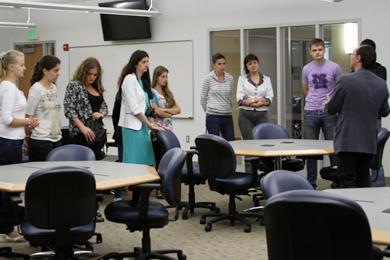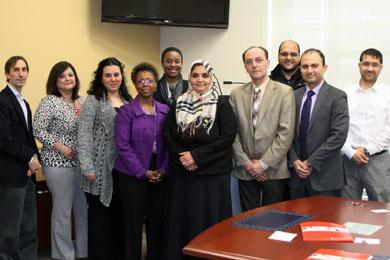SOP Hosts Pharmaceutical Scientists and Graduate Students from the Ukraine
Visitors met with faculty and students from the Department of Pharmaceutical Sciences and received a tour of Pharmacy Hall.

By Malissa Carroll
June 13, 2013
On June 7, 10 graduate students and two faculty members from the Ukrainian National University of Pharmacy visited the University of Maryland School of Pharmacy to learn about the School’s pharmaceutical sciences research program. Andrew Coop, PhD, professor and chair of the Department of Pharmaceutical Sciences (PSC) presented an overview of the School and gave group members a tour of Pharmacy Hall.
“I enjoyed speaking with the faculty and students from the Ukrainian National University of Pharmacy and sharing information about our School’s research and education initiatives, while also planning strategic collaborations with their institution and research programs,” says Coop. “Introducing faculty and graduate students from other parts of the world to the Department of Pharmaceutical Sciences and the School of Pharmacy is always a pleasure and often opens the door for future networking and collaboration opportunities.”
Coop’s presentation to the group outlined the educational programs at the school, as well as the types of research conducted by faculty in PSC, addressing all phases of basic science research, drug development, and clinical and translational sciences. He spotlighted the School’s Computer Aided Drug Design Center, led by Alexander MacKerell, PhD, Grollman-Glick Professor of Pharmaceutical Sciences at the School of Pharmacy, as well as the Center for Nanomedicine and Cellular Delivery, led by Peter Swaan, PhD, professor in PSC and associate dean for research and graduate studies.
He also spoke about the PSC graduate program, highlighting the relationship with the School’s Center of Excellence in Regulatory Science and Innovation, which was established as a collaborative partnership between the University of Maryland, Baltimore, the University of Maryland, College Park, and the Food and Drug Administration (FDA).
“When we host conferences at the School through the Center of Excellence in Regulatory Science and Innovation, we bring in professionals from organizations such as the FDA and the US Pharmacopeia,” said Coop. “This allows our current professional and graduate students the opportunity to interact and network with the same people who could potentially be responsible for hiring them in the future.”
Sarah Sushchyk, a PSC graduate student, discussed her research and the opportunities for collaboration among faculty and graduate students that exist at the School. She also answered students’ questions about life as a graduate student at the School of Pharmacy. “When you work in your field all day, it is refreshing to visit with other faculty and students to see what they are working on and what challenges they face. You would be surprised how much that can help you with your work,” said Sushchyk.
The group was also given a tour of Pharmacy Hall. Members had an opportunity to view the School’s Alfred Abramson Pharmacy Practice Lab (Fred Lab) and lecture halls, with one student remarking, “I wish the lecture halls at our university offered the same capabilities as those at the School of Pharmacy. The technology used in those rooms is so innovative.”
The tour also took the group inside the laboratories of several PSC faculty, where they had a chance to see the School’s state-of-the-art research facilities, including its Mass Spectrometry Facility, and watch graduate students conduct experiments first-hand. Stephen Hoag, PhD, professor in PSC and director of the School’s Good Manufacturing Practice (GMP) Facility, met with the group at the conclusion of the tour and provided an overview of the GMP Facility and its capabilities.
“Our GMP Facility includes suites for non-sterile manufacturing research and development, as well as fully equipped, modern research laboratories for analytical, preformulation, and formulation research,” said Hoag. “We have worked with researchers from across the University of Maryland, FDA, large and small pharmaceutical and biotechnology companies, and suppliers of chemicals and excipients with a wide range of projects.”
Following the tour, Coop fielded questions from the group and led a discussion about how the two schools might partner in the future on a wide range of education and research initiatives.



